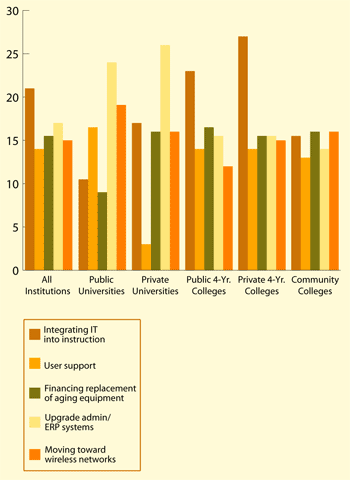Planning Priorities
The 2004 Campus Computing Survey indicates confidence in networks and online
resources—and reveals new attention to non-academically oriented technologies.
Institutions surveyed in the recently released 2004 Campus Computing survey
(www.campuscomputing.net)
rated several technology infrastructure categories from 3.7 to 6.0, on a poor-to-high
scale of 1 to 7 —indicating that despite some genuine confidence, there’s
room for improvement.
The 516 institutions responding to the 2004 survey (a 64 percent response rate)
told Campus Computing how well they thought they were doing in key technology
areas (see figure 1). Campus networks and online resources were the highest-rated
categories, perhaps a reflection of the high priority given to “instructional
integration of information technology” that was revealed in the data from
earlier years.
Interestingly, user support rates a high 5.5 on the scale in 2004; possibly
an anomaly, or even wishful thinking, if you consider that it was one of the
areas that took a big hit in recent budget struggles.
The campus portal comes in dead last; odd, given its potential impact and value
to boost the perception of the institution for both constituents and visitors.
The 2004 data also show that now almost 40 percent of all respondents and more
than 50 percent of universities have single-sign-on portals. Clearly, portals
are growing in importance. So why are they lowest in the ratings? And how do
strategic plans line up against these ratings?
In the 2004 data, there is a clear shift to less emphasis on integrating technology
in academic programs, than in previous years. No doubt this is not an intentional
move to abandon the academic side, but a more natural effort to play catch-up
in other areas. In other words, it’s all about making necessary choices with
tight technology funding. One cut of the Campus Computing 2004 data provides
a rough sketch of this shift in planning priorities (see figure 2).
With only 5.8 percent of respondents indicating that their institutions had
no technology plan in place or underway, “Who d'esn’t?” is the phrase that comes
to mind. Almost every institution has an IT plan, as they should!
But broad, sweeping plans for information technology can produce gaps or specific
areas that need to be addressed. Among those now receiving attention (perhaps
as a reaction to current events) are network security and disaster recovery,
with 89.2 and 87.8 percent of responding institutions, respectively, either
having or preparing a plan.
Other data from the 2004 survey show not only an emphasis on security, but
also a strong push for ERP systems. “The survey data confirm that institutions
feel compelled to invest in security and enhanced administrative information
(ERP) systems,” says Campus Computing’s Casey Green. In prior years, the respondents
had overwhelmingly identified “instructional integration in information technology”
as their “single most important issue” for the next two to three years. It’s
striking to see the bars for ERP beginning to push ahead of instructional integration
in the year 2004 (see figure 3), overshadowing other concerns for public and
private universities.
Strategic Plans
D'es your institution have a strategic plan for: |
| —Information Technology? |
| No |
5.8 |
| Yes |
70.0 |
| Currently Preparing |
24.2 |
| —Network Security? |
| No |
10.8 |
| Yes |
61.7 |
| Currently Preparing |
27.5 |
| —IT Disaster Recovery? |
| No |
12.2 |
| Yes |
55.5 |
| Currently Preparing |
32.3 |
Figure 2. Percentages by campus category.
Again, there’s clearly a push to catch up in areas other than instructional
technology. An awareness of the effects of external forces, business demands,
and emerging technology is key to understanding the shifting priorities of technology
planners.

Figure 1. Mean rating by campus technology infrastructure category. Scale:
1=poor; 7=excellent

Figure 3. Percentages, by campus type; top five issues (2004)